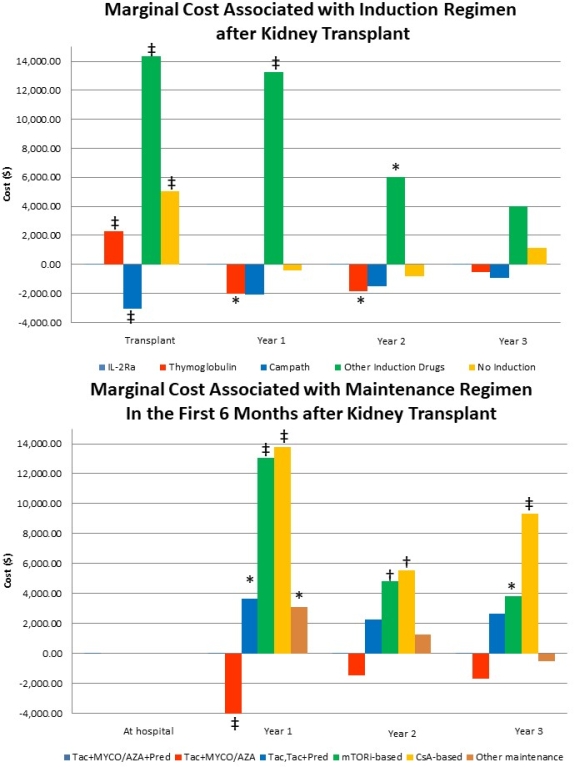Cost Impacts of Alternative Kidney Transplant Immunosuppression: A National Cohort Study
1Saint Louis Univ, St. Louis
2Lahey Clinic, Burlington
3Washington Univ, St. Louis
4Johns Hopkins, Baltimore
5Univ Michigan, Ann Arbor
6Univ Alberta, Edmonton, Canada
7Hennepin County, Minneapolis
8Symphony Health, Conshohocken.
Meeting: 2018 American Transplant Congress
Abstract number: 574
Keywords: Economics, Immunosuppression, Induction therapy, Kidney transplantation
Session Information
Session Name: Concurrent Session: Non-Organ Specific: Economics, Public Policy, Allocation, Ethics - 3
Session Type: Concurrent Session
Date: Tuesday, June 5, 2018
Session Time: 4:30pm-6:00pm
 Presentation Time: 5:06pm-5:18pm
Presentation Time: 5:06pm-5:18pm
Location: Room 4C-4
Economic outcomes are increasingly considered along with clinical efficacy to guide choice of alternative therapies. We examined the cost impact of kidney transplant (KTx) induction and maintenance suppression (ISx) in a large national US cohort.
Cost data for the transplant hospitalization were drawn from linkage of the national registry with financial records from the University HealthSystem Consortium of US academic hospitals (2002 –2013, N= 62,002 KTx). Cost of post-transplant care were estimated from Medicare Part A &B payments (N= 62,698). Marginal costs of induction (all periods) and maintenance (Yr 1, Yr 2, Yr 3) ISx were estimated from multivariate regression, including adjustment for baseline recipient, donor, and transplant factors.
Compared to IL2rAb, Thymoglobulin (TMG, $10,066) and other induction ($21,627) was associated with increased costs of the transplant hospitalization, while Campath was initially cost saving ($4,208 . Subsequently, patients induced with TMG had significantly lower costs in Yr1 ($2,108) and Yr 2 ($1,834) post-KTx.
Compared to triple maintenance ISx, steroid-free recipients incurred lower costs in Yr 1 ($4,011), while all other maintenance regimens were associated with higher costs in Yr 1. Patients who received mTORi-based and CsA-based ISx continued to incur higher costs in Yrs 2 and 3 post-KTx
Induction and maintenance ISx are associated with differential costs of care during the transplant hospitalization and post-transplant periods, which may be mediated by different complication rates. Initial higher costs of TMG induction appear to be followed by later cost savings.
CITATION INFORMATION: Lentine K., Axelrod D., Dharnidharka V., Xiao H., Brennan D., Segev D., Randall H., Ouseph R., Naik A., Lam N., Alhamad T., Kasiske B., Hess G., Schnitzler M. Cost Impacts of Alternative Kidney Transplant Immunosuppression: A National Cohort Study Am J Transplant. 2017;17 (suppl 3).
To cite this abstract in AMA style:
Lentine K, Axelrod D, Dharnidharka V, Xiao H, Brennan D, Segev D, Randall H, Ouseph R, Naik A, Lam N, Alhamad T, Kasiske B, Hess G, Schnitzler M. Cost Impacts of Alternative Kidney Transplant Immunosuppression: A National Cohort Study [abstract]. https://atcmeetingabstracts.com/abstract/cost-impacts-of-alternative-kidney-transplant-immunosuppression-a-national-cohort-study/. Accessed December 25, 2025.« Back to 2018 American Transplant Congress

